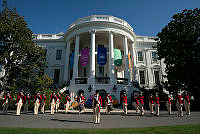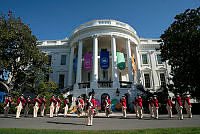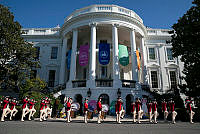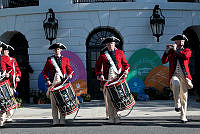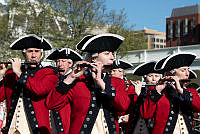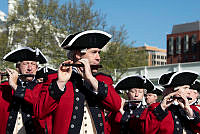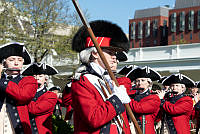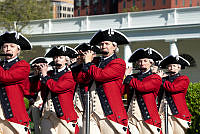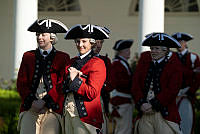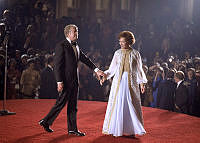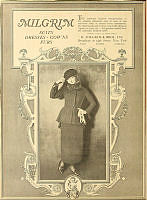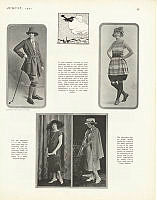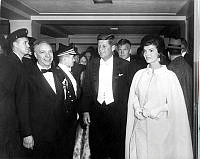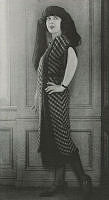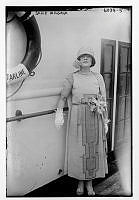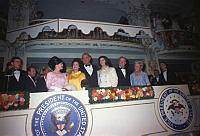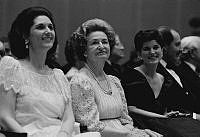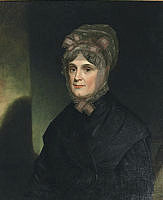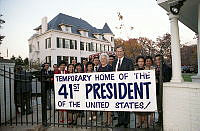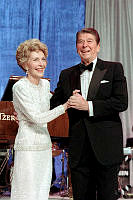Inaugural Balls
From Their Beginnings
Copyright © Fall 2004 White House Historical Association. All rights reserved under international copyright conventions. No part of this article may be reproduced or utilized in any form or by any means, electronic or mechanical, including photocopying, recording, or by any information storage and retrieval system, without permission in writing from the publisher. Requests for reprint permissions should be addressed to books@whha.org
Gallery
-

The building for President James Buchanan's inaugural ball in March 1857, was a temporary structure erected on Judiciary Square. The reported cost of the building was $15,000, and it boasted two rooms: one for dancing and one for eating.
Library of Congress -

The "superb costumes of distinguished ladies present" at President Abraham Lincoln's inauguration ball were illustrated in Frank Leslie's Illustrated Newspaper on March 23, 1861.
Library of Congress -

On March 20, 1869, President Grant held his first inaugural ball in the Cash Room of the north wing of the Treasury Department. In an attempt to ease overcrowding at his second inaugural ball, a temporary structure was erected on Judiciary Square. Though large enough to accommodate the crowds, no provisions were made for heating, and women spent the evening wearing their wraps while men kept on their coats and hats. The Cash Room, shown here has been restored to exactly this appearance.
Library of Congress -

On March 4, 1881, James A. Garfield became the first president to hold and inaugural celebration in a Smithsonian building. Garfield's ball was the first event held in the new Arts and Industries Building, today known as the National Museum Building. The building was still incomplete, and temporary wooden floors were installed expressly for the ball. The decorations included the initials of James A. Garfield and Vice President Chester A. Arthur, seen on the back wall, and a statue seen under the archway titled "The Statue of America," which boasted an electric torch. The electric light, still a novelty to most people in 1881, fascinated the merrymakers.
Smithsonian Institution Archives -

This engraving depicts guests dancing at President Benjamin Harrison's 1889 inaugural ball, which was held in the Pension Building, now the National Building Museum in Washington, D.C. The balconies are decorated with flags and the columns are wrapped in garlands and decorated with shields bearing the American flag.
Library of Congress -

The interior view of the Pension Building, the location of President McKinley's first inaugural ball on March 4, 1897.
Library of Congress -

A special dining room was reserved in the Pension Building for President McKinley and his party in 1901. Without a private room, the sheet number of people wishing to greet the new president would have made eating a meal impossible.
Library of Congress -

Elaborate decorations adorned the columns, balconies, and fountain of the Pension Building for President McKinley's second inaugural ball in 1901. Elaborate schematic drawings were executed to plan all details of the decorations, and a special subcommittee of the main Presidential Inaugural Committee focused all of its energies on inaugural ball decorations.
Library of Congress -

The interior view of the Washington Auditorium at 19th Street and New York Avenue shows a large crowd at President Herbert Hoover's inaugural ball on March 4, 1929. The growing popularity of celebratory events surrounding the inaugural and the presidency itself necessitated multiple balls around the city to accommodate the crowds.
Library of Congress -

President and Mrs. Jimmy Carter wished to appear approachable to the American people. Earlier that day after taking that oath of office, President Carter and his family walked down Pennsylvania Avenue from the Capitol to the White House instead of being driven, as was the precedent. At his inauguration ball in 1977, he and Mrs. Carter greeted guests and danced among the crowds.
Library of Congress -

In this photograph taken in 1985, President Ronald Reagan and his wife, First Lady Nancy Reagan, pose and wave to guests during one of their inaugural balls. The couple were celebrating the President's second inauguration.
Ronald Reagan Presidential Library and Museum/NARA -

In 1989 President George Bush dances with his wife Barbara at one of his eleven inaugural balls.
George Bush Presidential Library and Museum/NARA -

President George W. Bush and Laura Bush dance at his inaugural ball on January 20, 2001.
White House Historical Association
Three key features characterize nearly every presidential inauguration: the oath of office taken by the president at the Capitol, the inaugural parade, and the inaugural ball. Yet Article II, section 1, of the United States Constitution requires only the first mere 35-word pledge. Although no further instructions were left for subsequent events, celebration has always been an inseparable element. The military display that greeted George Washington upon his arrival in New York for the first inauguration in 1789 has evolved into more formal, more magnificent pageantry as America and the American presidency have grown.
Initially, local committees of District of Columbia citizens organized the celebrations surrounding the inauguration. As the events grew larger, more official, and more elaborate, so did the committees organizing them. A joint resolution was passed on January 28, 1881, as Washington prepared for the inauguration of President-elect James A. Garfield. The resolution of the Presidential Inaugural Committee, whose chairman was appointed by the president-elect, and authorized the War and Navy Departments to lend logistical support. A joint resolution renewing assistance from the District of Columbia and federal governments was passed every inauguration until 1953. Finally the Presidential Inaugural Ceremonies Act of August 6, 1956, made federal and D.C. government assistance permanent.1
An organization of young men called the Washington Dancing Assembly, whose purpose it was to throw parties for members of Washington society, was the first group of citizens to organize an inaugural event. To honor President James Madison and his wife, Dolley, popular members of Washington’s social scene, they planned a ball to follow the inauguration in 1809. Contemporaries reported that 400 guests attended the first inaugural ball, held on Saturday evening, March 4, 1809, at Mr. Long’s Hotel on Capitol Hill.2 The first ball was a great success, and it set a precedent. One hundred years later in 1909, Harper’s Weekly wrote, “Probably no feature of the inaugural ceremonies at Washington is of such interest to visitors as the inaugural ball.”3
Initially, the inaugural balls were held in local hotels: Long’s, site of Madison’s inaugural ball; Davis’ later called the Metropolitan Hotel; and Carusi’s, owned by members of the celebrated family orchestra. As Washington’s population grew, as travel became more convenient, and as the inauguration and the presidency rose in public importance, the demand for tickets to the inaugural ball grew as well. Spaces large enough to accommodate the crowds were at a premium, and large government buildings offered a solution for a few presidents. The first was Abraham Lincoln, whose second inaugural ball in 1865 was held in the model room of the Patent Office. Four years later Ulysses S. Grant entertained inaugural guests in the north wing of the Treasury Building. Temporary structures were also erected on Judiciary Square for the sole purpose of the inaugural ball: first for Zachary Taylor in 1849, then for James Buchanan in 1857, and for Ulysses S. Grant’s second ball in 1873. The structure for Grant was reported to be 350 by 150 feet, with an extremely plain exterior. The floor was constructed separately from the rest of the structure to prevent the shaking of the walls and roof if dancing became too lively. Despite frigid temperatures and a lack of heaters in the structure, newspaper accounts reported only the splendor. “The inaugural ball building… is nearly ready for the brilliant scene for which it was erected… the interior arrangements and decorations are superb, and excel those in any building ever erected before for like purposes.4
When the Pension Building designed by Montgomery C. Meigs was built at Judiciary Square, its vast interior courtyard and fountain, along with two levels of galleries, made it a popular venue for inaugural balls. President Grover Cleveland’s ball was the first held in the building in 1885, two years before its completion. Despite the spacious interior of the Pension Building, the demand to attend the inaugural ball was so great that neither that Great Hall nor any other single space in Washington could accommodate the crowds, and multiple balls were held throughout the city. This arrangement remains the custom today.




